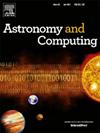基于流形学习的星系形态分类
IF 1.8
4区 物理与天体物理
Q2 ASTRONOMY & ASTROPHYSICS
引用次数: 0
摘要
我们使用经典的机器学习技术解决了来自Galaxy Zoo DECaLS数据集的星系形态分类问题。我们的方法采用降维方法,然后使用经典分类器根据形状(雪茄/中间/圆形;边缘/正面)和纹理(光滑/有特色)。我们评估了各种降维方法,包括局部线性嵌入(LLE)、等高线图、均匀流形逼近和投影(UMAP)、t-SNE和主成分分析(PCA)。我们的研究结果表明,大多数经典分类器在与LLE结合时达到了最高的性能,达到了与简单神经网络相当的精度。此外,在形状分类的情况下,三维表示仍然是可解释的,这与通常观察到的非线性转换后可解释性的丧失形成了对比。此外,我们探索了k-means聚类之后的降维,以评估数据是否表现出向特定数量的聚类的自然趋势。我们使用轮廓、肘部、邓恩和戴维斯-博尔丁评分来评估聚类性能。虽然戴维斯-布尔丁的评分表明了对四个星团的轻微偏好——与人类天文学家的分类密切相关——但其他指标并不支持一个独特的星团结构。本文章由计算机程序翻译,如有差异,请以英文原文为准。
Galaxy morphological classification with manifold learning
We address the problem of morphological classification of galaxies from the Galaxy Zoo DECaLS dataset using classical machine learning techniques. Our approach employs a dimensionality reduction method followed by a classical classifier to categorize galaxies based on shape (cigar/in-between/ round; edge-on/face-on) and texture (smooth/featured). We evaluate various dimensionality reduction methods, including Locally Linear Embedding (LLE), Isomap, Uniform Manifold Approximation and Projection (UMAP), t-SNE, and Principal Component Analysis (PCA). Our results demonstrate that most classical classifiers achieve their highest performance when combined with LLE, attaining accuracy comparable to that of simple neural networks. Moreover, in the case of shape classification, the three-dimensional representation remains interpretable, in contrast to the commonly observed loss of interpretability following nonlinear transformations. Additionally, we explore dimensionality reduction followed by k-means clustering to assess whether the data exhibits a natural tendency toward a specific number of clusters. We evaluate clustering performance using silhouette, elbow, Dunn, and Davies–Bouldin scores. While the Davies–Bouldin score indicates a slight preference for four clusters — closely aligning with classifications made by human astronomers — the other metrics do not support a distinct clustering structure.
求助全文
通过发布文献求助,成功后即可免费获取论文全文。
去求助
来源期刊

Astronomy and Computing
ASTRONOMY & ASTROPHYSICSCOMPUTER SCIENCE,-COMPUTER SCIENCE, INTERDISCIPLINARY APPLICATIONS
CiteScore
4.10
自引率
8.00%
发文量
67
期刊介绍:
Astronomy and Computing is a peer-reviewed journal that focuses on the broad area between astronomy, computer science and information technology. The journal aims to publish the work of scientists and (software) engineers in all aspects of astronomical computing, including the collection, analysis, reduction, visualisation, preservation and dissemination of data, and the development of astronomical software and simulations. The journal covers applications for academic computer science techniques to astronomy, as well as novel applications of information technologies within astronomy.
 求助内容:
求助内容: 应助结果提醒方式:
应助结果提醒方式:


